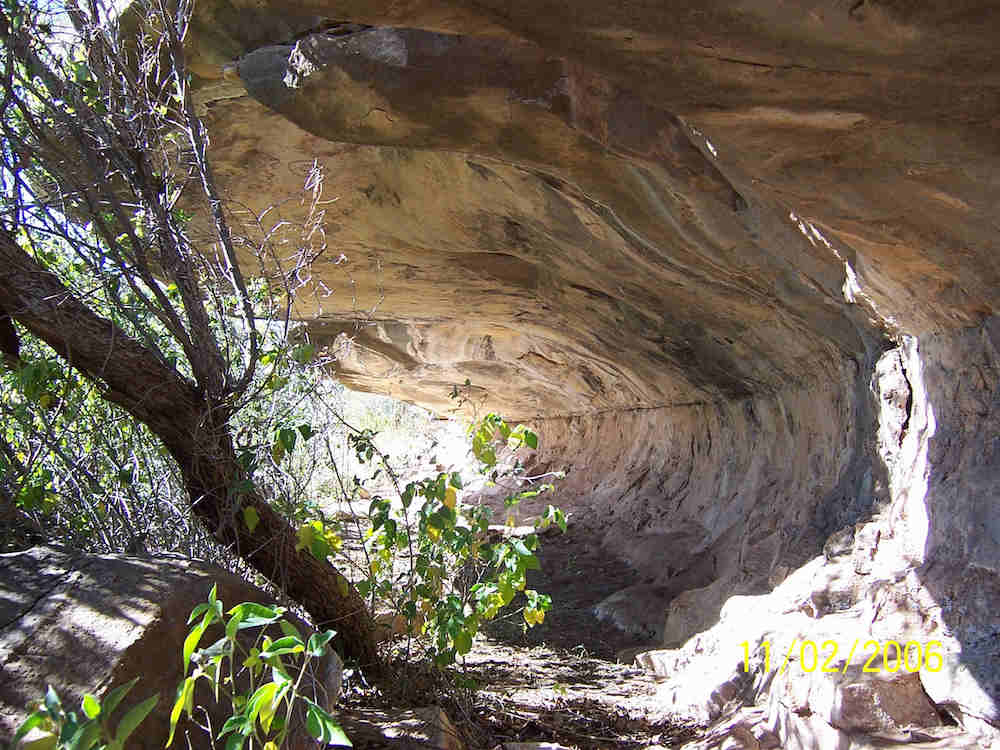Seasonality

Bedrock overhang at LA148560 Ruby Canyon, where people would have sought shelter from the elements. Photo courtesy of Bureau of Land Management, Carlsbad Field Office.
Throughout southeast New Mexico, peoples in the past moved with the seasons. Hot, dry summers and cold, wet winters shaped where communities moved, and when. Nomadic life relies on the movement and seasonality of plants and animals. Prehistorically, peoples followed these resources as they migrated and changed with the cycles of the earth.
On the Move
Much of what we know today about prehistoric subsistence strategies comes from looking at the archaeological record. We can learn where people went, what they ate, and what was in season, all by looking at what they left behind. However, to learn more, we turn to the peoples connected to the archaeological record. Oral histories tell of life in the past from the descendants of the peoples who lived it.
The Mescalero Apache people have moved across the landscape of southeast New Mexico since time immemorial. Their oral traditions tell of seasonal movement across the land, following resources as the weather changed throughout the year. “The Mescalero ideally moved in a generally clockwise circle from autumn camps in the plains grasslands, southward and downward to winter camps in the desert basins, northward and upward to spring camps in the wooded uplands, and on northward and upward to summer mountain camps. Then the cycle repeated, as regularly as sacred liturgy…” (Railey 2016).
This movement isn’t just a survival method, but is intimately woven into the Mescalero Apache religion and ceremony. Mescalero Apache oral history tells of “the Child of Water [who] moves in a clockwise direction through the landscape, conquering four primordial monsters and ‘establishing a model for human action, a core paradigm for Apache beliefs and values’” (Goss 2004:178).
Spring and Summer
In spring and summer, people gathered pinon nuts in the Guadalupe Mountains and mesquite beans in the low-lands. Communities harvested mescal in the late spring-early summer. During this season, the mescal plant absorbs all of the sugars and nutrients from its roots. Peoples looked for the plant to sprout its flowering stalk, signaling that the agave heart is at its sweetest. The warmer months also bring prickly-pear, cholla, and banana yucca fruit.
While plants were readily available, past peoples traveled to seek out migrating animals. Rabbits, deer, and bison could be found in different portions of southeast New Mexico. In the heat, many animals like deer escaped to the higher elevations.
No matter the season, life can be found where the water is flowing. Throughout the spring and summer especially, people, plants, and animals in southeast New Mexico seek out fresh water sources.
Fall and Winter
In the fall and winter, communities traveled to the lower grasslands and river valley areas. Hunting animals played a bigger role during the colder months, as many harvested plants would fall dormant. Migratory birds moved into the area during the fall and winter, and deer would come down from their higher elevation summer homes.
Along with hunting, peoples could rely on stored plant foods from the spring and summer. Often, plants could be dried or cured and stored for long periods of time. These stockpiles of harvested plants were important to keeping a balanced diet throughout the winter.
While rare in the archaeological record, there is some evidence of maize cultivation. The adoption of maize farming coincided with larger populations, trade, and more sedentary lifestyles with less seasonal mobility across the landscape, signaling a new relationship with the changing seasons.
Peoples across southeast New Mexico have always migrated with the seasons. The plants, animals, and water sources controlled where and when people traveled. As you explore the archaeological sites on this website, think about seasonality and why people may have chosen to stop at these places. The many communities and families who lived across southeast New Mexico throughout prehistory were highly mobile, and relied on the cycles of the earth to provide what they needed.
To explore the archaeological sites featured on this website, visit our section featuring notable sites.
